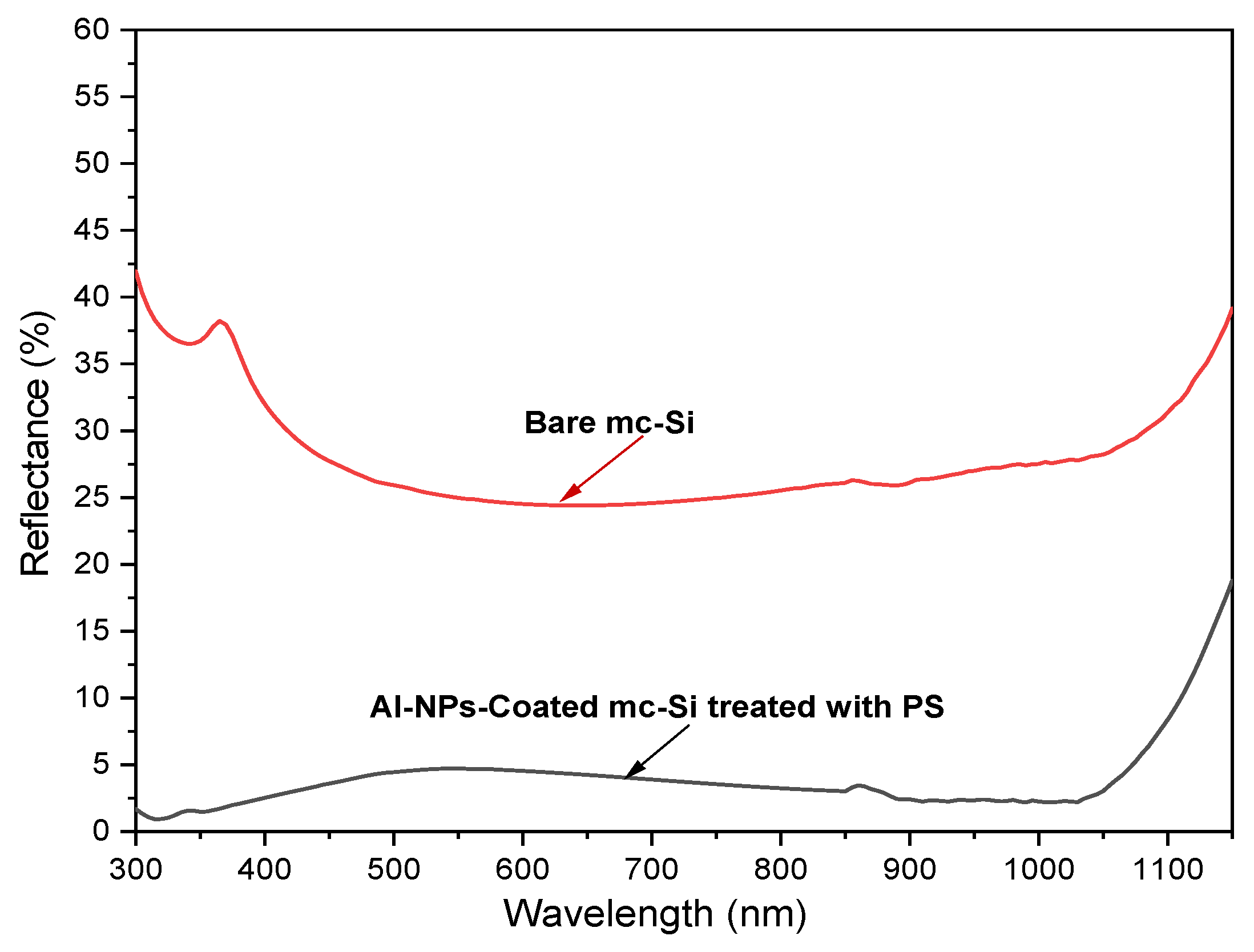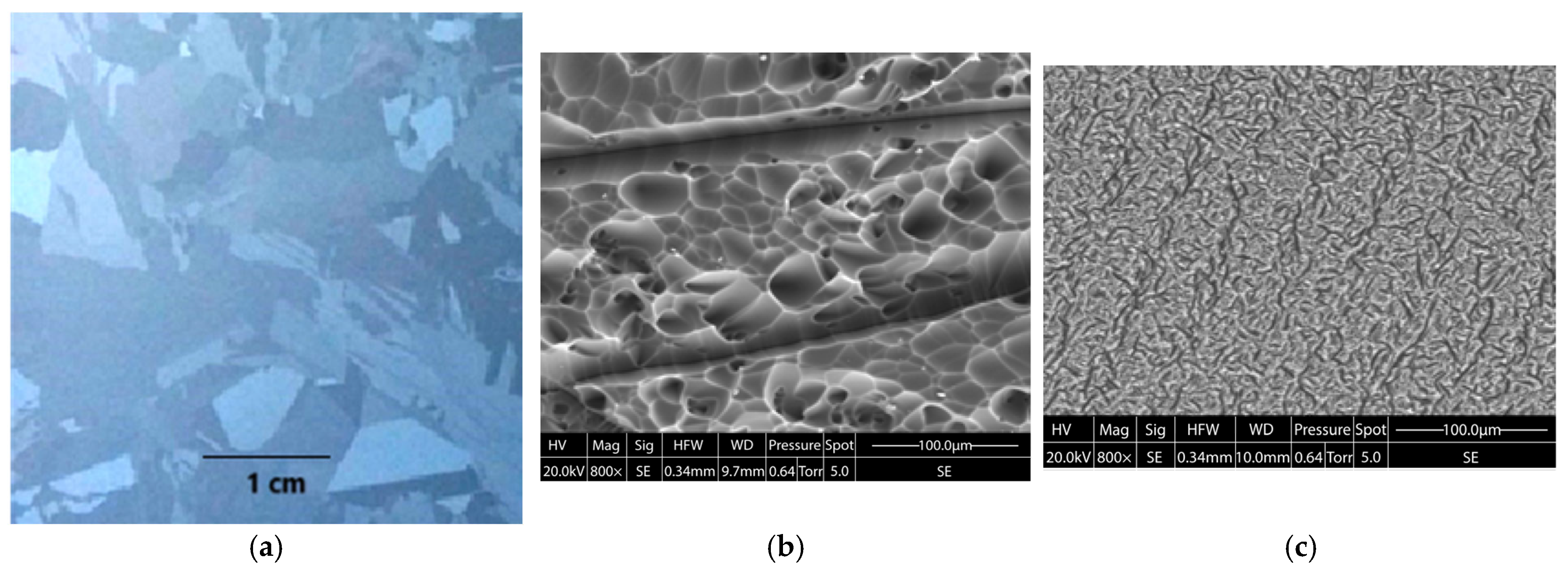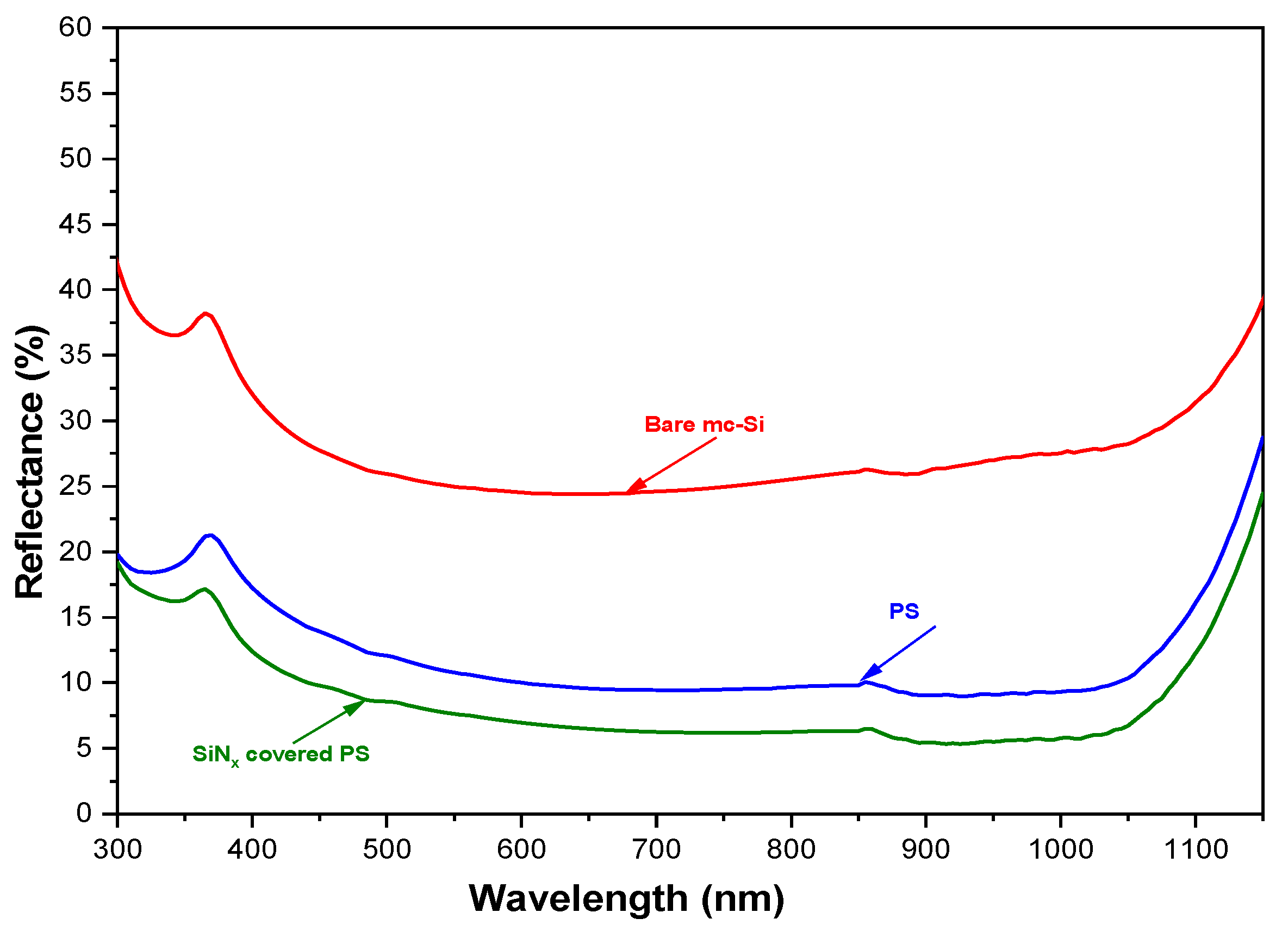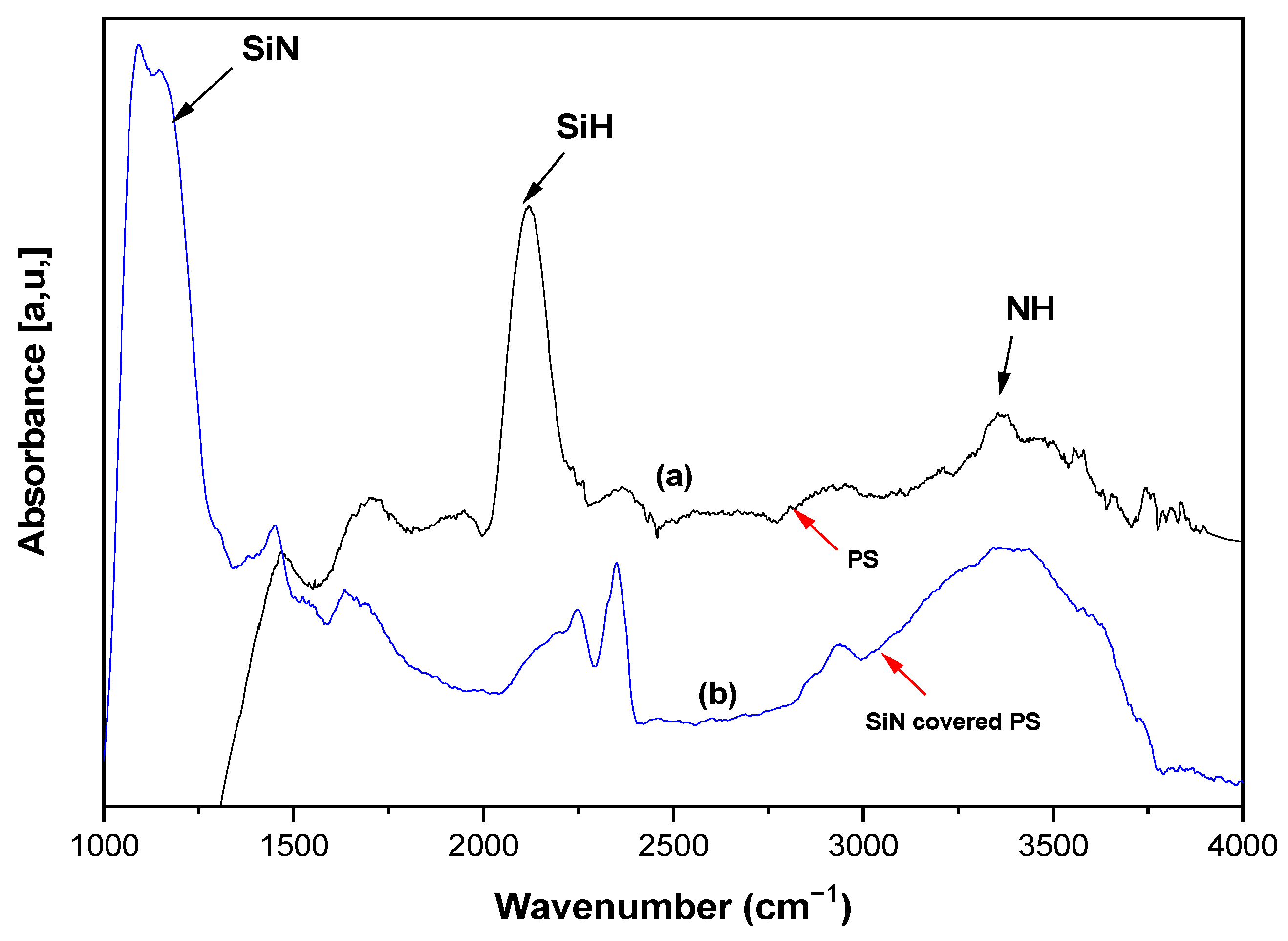Enhancement of Optoelectronic Properties of Multicrystalline Silicon Using Al-NPs and SiNx Layer
Abstract
:1. Introduction
2. Materials and Methods
3. Results and Discussion
4. Conclusions
Author Contributions
Funding
Data Availability Statement
Conflicts of Interest
References
- Burtescu, S.; Parvulescu, C.; Babarada, F.; Manea, E. The low cost multicrystalline silicon solar cells. Mater. Sci. Eng. B 2009, 165, 190–193. [Google Scholar] [CrossRef]
- Lan, C.W.; Hsu, C.; Nakajima, K. Multicrystalline silicon crystal growth for photovoltaic applications. In Handbook of Crystal Growth; Elsevier: Amsterdam, The Netherlands, 2015; pp. 373–411. [Google Scholar]
- Yu, W.; Xue, Y.; Mei, J.; Zhou, X.; Xiong, M.; Zhang, S. Segregation and removal of transition metal impurities during the directional solidification refining of silicon with Al-Si solvent. J. Alloys Compd. 2019, 805, 198–204. [Google Scholar] [CrossRef]
- Lv, X.; Li, H.; Ding, D.; Yu, X.; Jin, C.; Yang, D. Interfacial characterization of non-metal precipitates at grain boundaries in cast multicrystalline silicon crystals. J. Cryst. Growth 2025, 652, 128042. [Google Scholar] [CrossRef]
- Wang, L.; Liu, J.; Li, Y.; Wei, G.; Li, Q.; Fan, Z.; He, D. Dislocations in Crystalline Silicon Solar Cells. Adv. Energy Sustain. Res. 2024, 5, 2300240. [Google Scholar] [CrossRef]
- Alrasheedi, N.H. The Effects of Porous Silicon and Silicon Nitride Treatments on the Electronic Qualities of Multicrystalline Silicon for Solar Cell Applications. Silicon 2024, 16, 1765–1773. [Google Scholar] [CrossRef]
- Zhou, R.; Li, W.; Ge, B.; Song, J.; Su, Q.; Xi, M.; Liu, Y. Optimization of the deposited Al2O3 thin film process by RS-ALD and edge passivation applications for half-solar cells. Ceram. Int. 2025, 51, 2840–2845. [Google Scholar] [CrossRef]
- Chen, J.; Chen, B.; Lee, W.; Fukuzawa, M.; Yamada, M.; Sekiguchi, T. Grain boundaries in multicrystalline si. Solid State Phenom. 2010, 156, 19–26. [Google Scholar] [CrossRef]
- Woo, S.; Bertoni, M.; Choi, K.; Nam, S.; Castellanos, S.; Powell, D.M.; Choi, H. An insight into dislocation density reduction in multicrystalline silicon. Sol. Energy Mater. Sol. Cells 2016, 155, 88–100. [Google Scholar] [CrossRef]
- Zhang, Y.; Sun, J.; Li, X.; Zhang, D.; Tao, K.; Jiang, S.; Jia, R. Improved performance on multi-crystalline silicon solar cells by optimizing aluminum back surface field process. Mater. Sci. Semicond. Process. 2021, 132, 105916. [Google Scholar] [CrossRef]
- Ayvazyan, G. Crystalline and Porous Silicon. In Black Silicon: Formation, Properties, and Application; Springer Nature Switzerland: Cham, Switzerland, 2024; pp. 1–49. [Google Scholar]
- Lipinski, M.; Panek, P.; Bełtowska, E.; Czternastek, H. Reduction of surface reflectivity by using double porous silicon layers. Mater. Sci. Eng. B 2003, 101, 297–299. [Google Scholar] [CrossRef]
- Mogoda, A.S.; Farag, A.R. The effects of a few formation parameters on porous silicon production in HF/HNO3 using ag-assisted etching and a comparison with a stain etching method. Silicon 2022, 14, 11405–11415. [Google Scholar] [CrossRef]
- Rabha, M.B.; Hajji, M.; Mohamed, S.B.; Hajjaji, A.; Gaidi, M.; Ezzaouia, H.; Bessais, B. Stain-etched porous silicon nanostructures for multicrystalline silicon-based solar cells. Eur. Phys. J.-Appl. Phys. 2012, 57, 21301. [Google Scholar] [CrossRef]
- Faltakh, H.; Bourguiga, R.; Rabha, M.B.; Bessais, B. Simulation and optimization of the performance of multicrystalline silicon solar cell using porous silicon antireflection coating layer. Superlattices Microstruct. 2014, 72, 283–295. [Google Scholar] [CrossRef]
- Ge, D.; Fang, Z.; Zhao, C.; Shi, J.; Zhang, L. Preparation and anti-reflection performance of porous silicon/gold nanocomposite structures. Eur. Phys. J. D 2023, 77, 108. [Google Scholar] [CrossRef]
- Fzaa, W.T.; Tomaa, G.A.; al Qaisy, H.Q.K.; Mutlak, F.A.H. Characterization of the anti-reflectance laser-assisted etched silicon micro-nano structure for solar cell application. J. Opt. 2024, 1–8. [Google Scholar] [CrossRef]
- Harbeke, G.; Jastrzebski, L. Assessment of the surface quality of SIMOX wafers by UV reflectance. J. Electrochem. Soc. 1990, 137, 696. [Google Scholar] [CrossRef]
- Rabha, M.B.; Salem, M.; El Khakani, M.A.; Bessais, B.; Gaidi, M. Monocrystalline silicon surface passivation by Al2O3/porous silicon combined treatment. Mater. Sci. Eng. B 2013, 178, 695–697. [Google Scholar] [CrossRef]
- Cuevas, A.; Macdonald, D. Measuring and interpreting the lifetime of silicon wafers. Sol. Energy 2004, 76, 255–262. [Google Scholar] [CrossRef]
- Khezami, L.; Jemai, A.B.; Alhathlool, R.; Rabha, M.B. Electronic quality improvement of crystalline silicon by stain etching-based PS nanostructures for solar cells application. Sol. Energy 2016, 129, 38–44. [Google Scholar] [CrossRef]
- Porre, O.; Martinuzzi, S.; Pasquinelli, M.; Perichaud, I.; Gay, N. Gettering effect of aluminium in mc-Si and c-Si wafers and in solar cells. In Proceedings of the Conference Record of the Twenty Fifth IEEE Photovoltaic Specialists Conference, Washington, DC, USA, 13–17 May 1996. [Google Scholar]
- Harraz, F.A.; Sakka, T.; Ogata, Y.H. Immersion plating of nickel onto a porous silicon layer from fluoride solutions. Phys. Status Solidi (A) 2003, 197, 51–56. [Google Scholar] [CrossRef]
- Rahmani, M.; Moadhen, A.; Zaibi, M.A.; Elhouichet, H.; Oueslati, M. Photoluminescence enhancement and stabilisation of porous silicon passivated by iron. J. Lumin. 2008, 128, 1763–1766. [Google Scholar] [CrossRef]
- Arnoldbik, W.M.; Habraken, F.H.P.M. Swift heavy ion induced modifications of silicon (sub) oxide nitride layer structures. Nucl. Instrum. Methods Phys. Res. Sect. B Beam Interact. Mater. At. 2007, 256, 300–304. [Google Scholar] [CrossRef]
- Kanemitsu, Y.; Okamoto, S. Resonantly excited photoluminescence from porous silicon: Effects of surface oxidation on resonant luminescence spectra. Phys. Rev. B 1997, 56, R1696. [Google Scholar] [CrossRef]
- Maruyama, T.; Ohtani, S. Photoluminescence of porous silicon exposed to ambient air. Appl. Phys. Lett. 1994, 65, 1346–1348. [Google Scholar] [CrossRef]
- Kanemitsu, Y.; Futagi, T.; Matsumoto, T.; Mimura, H. Origin of the blue and red photoluminescence from oxidized porous silicon. Phys. Rev. B 1994, 49, 14732. [Google Scholar] [CrossRef]
- Stannowski, B.; Rath, J.K.; Schropp, R.E.I. Growth process and properties of silicon nitride deposited by hot-wire chemical vapor deposition. J. Appl. Phys. 2003, 93, 2618–2625. [Google Scholar] [CrossRef]
- Lelièvre, J.F.; Fourmond, E.; Kaminski, A.; Palais, O.; Ballutaud, D.; Lemiti, M. Study of the composition of hydrogenated silicon nitride SiNx: H for efficient surface and bulk passivation of silicon. Sol. Energy Mater. Sol. Cells 2009, 93, 1281–1289. [Google Scholar] [CrossRef]
- Dao, V.A.; Heo, J.; Kim, Y.; Kim, K.; Lakshminarayan, N.; Yi, J. Optimized surface passivation of n and p type silicon wafers using hydrogenated SiNx layers. J. Non-Cryst. Solids 2010, 356, 2880–2883. [Google Scholar] [CrossRef]
- Dimassi, W.; Derbali, L.; Bouaıcha, M.; Bessaıs, B.; Ezzaouia, H. Two-dimensional LBIC and Internal-Quantum-Efficiency investigations of grooved grain boundaries in multicrystalline silicon solar cells. Sol. Energy 2011, 85, 350–355. [Google Scholar] [CrossRef]
- Ben Rabha, M.; Dimassi, W.; Bouaicha, M.; Ezzaouia, H.; Bessais, B. Laser-beam-induced current mapping evaluation of porous silicon-based passivation in polycrystalline silicon solar cells. Sol. Energy 2009, 83, 721. [Google Scholar] [CrossRef]
- Achref, M.; Khezami, L.; Mokraoui, S.; Rabha, M.B. Effective surface passivation on multi-crystalline silicon using aluminum/porous silicon nanostructures. Surf. Interfaces 2020, 18, 100391. [Google Scholar] [CrossRef]
- Krotkus, A.; Grigoras, K.; Pacebutas, V.; Barsony, I.; Vazsonyi, E.; Fried, M.; Szlafcik, J.; Nijs, J.; Levy-Clement, C. Efficiency improvement by porous silicon coating of multicrystalline solar cells. Sol. Energy Mater. Sol. Cells 1997, 45, 267. [Google Scholar] [CrossRef]








| Reflectivity at 930 nm (%) | Diffusion Length (µm) | Generated Current (nA) | |
|---|---|---|---|
| Bare mc-Si | 27 | 2 | 1–2.8 |
| Al-NPs-Coated mc-Si treated with PS | 5 | 100 | 7.8–34 |
| mc-Si with PS-Covered SiNx | 2 | 300 | 37–66 |
Disclaimer/Publisher’s Note: The statements, opinions and data contained in all publications are solely those of the individual author(s) and contributor(s) and not of MDPI and/or the editor(s). MDPI and/or the editor(s) disclaim responsibility for any injury to people or property resulting from any ideas, methods, instructions or products referred to in the content. |
© 2025 by the authors. Licensee MDPI, Basel, Switzerland. This article is an open access article distributed under the terms and conditions of the Creative Commons Attribution (CC BY) license (https://creativecommons.org/licenses/by/4.0/).
Share and Cite
Ben Rabha, M.; El Haj, A.; Mannai, A.; Choubani, K.; Almeshaal, M.A.; Dimassi, W. Enhancement of Optoelectronic Properties of Multicrystalline Silicon Using Al-NPs and SiNx Layer. Crystals 2025, 15, 381. https://doi.org/10.3390/cryst15040381
Ben Rabha M, El Haj A, Mannai A, Choubani K, Almeshaal MA, Dimassi W. Enhancement of Optoelectronic Properties of Multicrystalline Silicon Using Al-NPs and SiNx Layer. Crystals. 2025; 15(4):381. https://doi.org/10.3390/cryst15040381
Chicago/Turabian StyleBen Rabha, Mohamed, Ameny El Haj, Achref Mannai, Karim Choubani, Mohammed A. Almeshaal, and Wissem Dimassi. 2025. "Enhancement of Optoelectronic Properties of Multicrystalline Silicon Using Al-NPs and SiNx Layer" Crystals 15, no. 4: 381. https://doi.org/10.3390/cryst15040381
APA StyleBen Rabha, M., El Haj, A., Mannai, A., Choubani, K., Almeshaal, M. A., & Dimassi, W. (2025). Enhancement of Optoelectronic Properties of Multicrystalline Silicon Using Al-NPs and SiNx Layer. Crystals, 15(4), 381. https://doi.org/10.3390/cryst15040381








